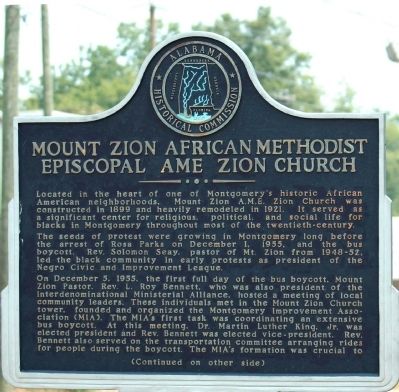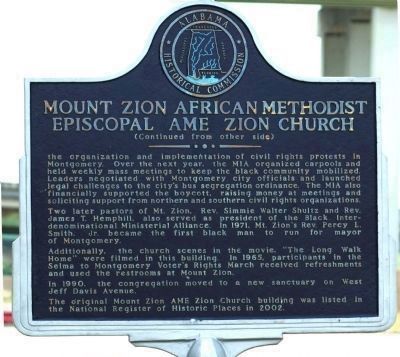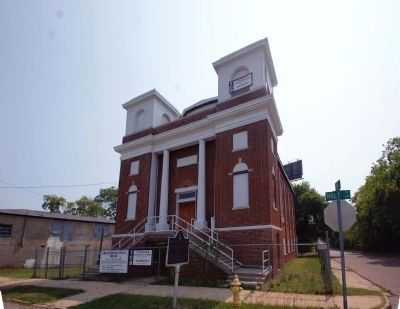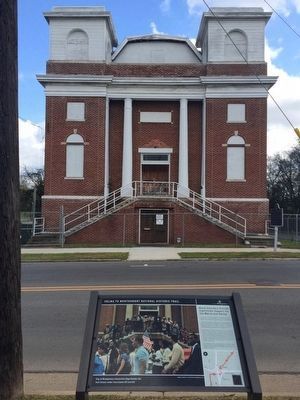Mount Zion African Methodist Episcopal AME Zion Church
Located in the heart of one of Montgomery's historic African-American neighborhoods. Mount Zion A.M.E. Zion Church was constructed in 1899 and heavily remodeled in 1921. It served as a significant center for religious, political, and social life for blacks in Montgomery throughout most of the twentieth-century. The seeds of protest were growing in Montgomery long before the arrest of Rosa Parks on December 1, 1955, and the bus boycott. Rev. Solomon Seay, pastor of Mt. Zion from 1948-52, led the black community in early protests as president of the Negro Civic and Improvement League.
On December 5, 1955, the first full day of the bus boycott, Mount Zion Pastor, Rev. Roy Bennett, who was also president of the Interdenominational Ministerial Alliance, hosted a meeting of local community leaders. These individuals met in the Mount Zion Church tower, founded and organized the Montgomery Improvement Association (MIA). The MIA's first task was coordinating an extensive bus boycott. At this meeting Dr. Martin Luther King, Jr. was elected president and Rev. Bennett was elected vice-president. Rev. Bennett also served on the transportation committee arranging rides for people during the boycott. The MIA's formation was crucial to
Side 2
the organization and implementation of civil rights protests in Montgomery. Over the next year the MIA organized carpools and held weekly mass meeting to keep the black community mobilized. Leaders negotiated with Montgomery city officials and launched legal challenges to the city's bus segregation ordinances. The MIA also financially supported the boycott, raising money at meetings and soliciting support from northern and southern civil rights organizations.
Two later pastors of Mt. Zion, Rev. Simmie Walter Schultz and Rev. James T. Hemphill, also served as president of the Black Interdenominational Ministerial Alliance. In 1971, Mt. Zion's Rev. Percy L. Smith, Jr. became the first black man to run for mayor of Montgomery.
Additionally, the church scenes in the movie, “The Long Walk Home” were filmed in this building. In 1965 participants in the Selma to Montgomery Voter Rights March received refreshments and used the restrooms at Mount Zion.
In 1990, the congregation moved to a new sanctuary on West Jeff Davis Avenue.
The original Mount Zion AME Zion Church building was listed in the National Register of Historical Places in 2002.
Erected 2002 by National Register of Historic Places.
Topics and series. This historical marker is listed in these topic lists: African Americans • Churches & Religion
Location. 32° 22.1′ N, 86° 19.233′ W. Marker is in Montgomery, Alabama, in Montgomery County. Marker is on Holt Street. Touch for map. Marker is at or near this postal address: 467 Holt street, Montgomery AL 36108, United States of America. Touch for directions.
Other nearby markers. At least 8 other markers are within walking distance of this marker. Black Churches Provide Significant Support for the March and Voting (a few steps from this marker); Sherman W. White, Jr. (approx. 0.2 miles away); Highway Construction Destroys Historic Black Neighborhoods (approx. 0.2 miles away); Four Points: One of Several Black Business Hubs in Montgomery (approx. ¼ mile away); Day Street Baptist Church (approx. ¼ mile away); Holt Street Baptist Church (approx. ¼ mile away); Loveless School / Henry Allen Loveless (approx. ¼ mile away); From Bus Boycott to Voting Rights: Community Activism 1955-65 (approx. ¼ mile away). Touch for a list and map of all markers in Montgomery.
Credits. This page was last revised on June 16, 2016. It was originally submitted on June 20, 2011, by Dodson M. Curry of Birmingham, Alabama. This page has been viewed 1,631 times since then and 44 times this year. Last updated on July 28, 2015, by J. Makali Bruton of Accra, Ghana. Photos: 1. submitted on June 22, 2011, by Dodson M. Curry of Birmingham, Alabama. 2, 3. submitted on June 20, 2011, by Dodson M. Curry of Birmingham, Alabama. 4. submitted on December 11, 2015, by Mark Hilton of Montgomery, Alabama. • Bernard Fisher was the editor who published this page.



